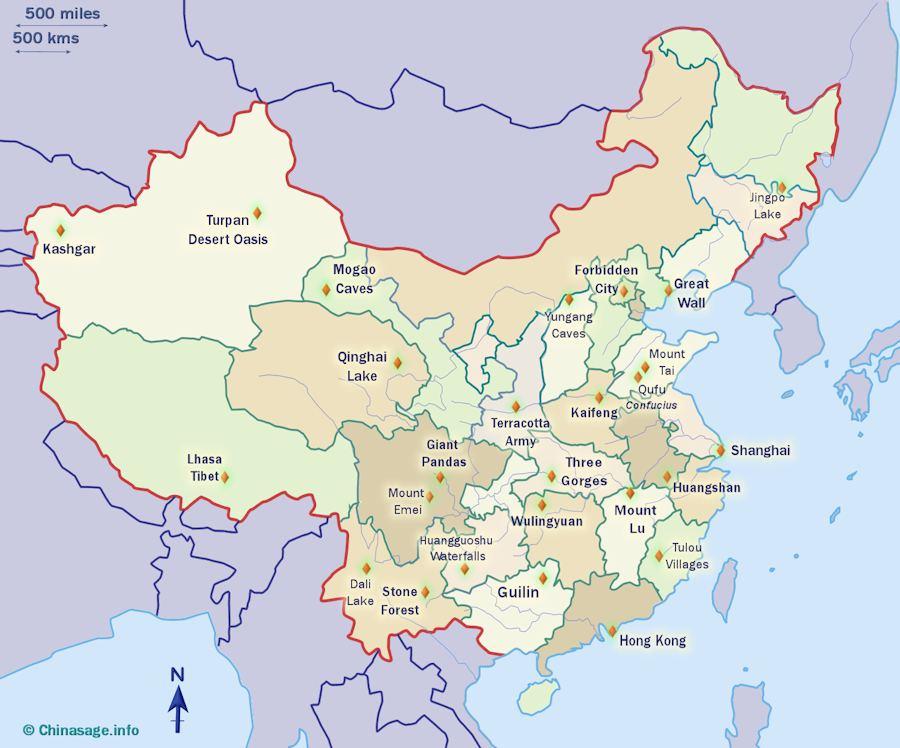Top places to visit in China
On this page we describe some of the top visitor attractions in China. Our descriptions of all the individual provinces give details of many other attractions.
Forbidden City
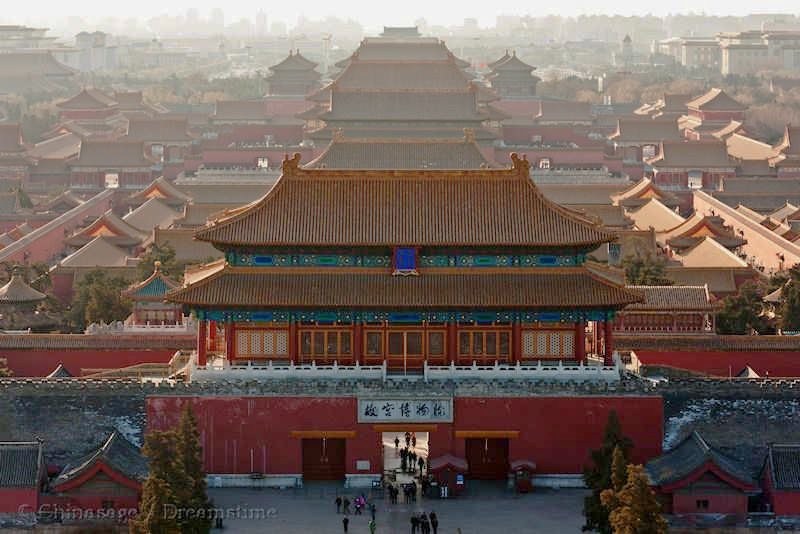
Any visitor could happily spend weeks exploring China's historic capital city Beijing. On this page we have restricted ourselves to one highlight for each city.
For Beijing this must surely be the former Imperial Palace - the famous Forbidden City (紫禁城 Zǐ jìn chéng). This huge complex of buildings (reputedly of 9,999 rooms) is laid out symmetrically to give an imposing collection of halls and courtyards that housed the Imperial family and the thousands of eunuchs and concubines that served the Emperor. It is the largest and best preserved collection of ancient buildings in China. As most of the buildings are of wood they require regular renovation, most were built in the Qing dynasty but to the same master plan that was drawn up in the Ming dynasty when they moved their capital from Nanjing to Beijing in 1421.
Read more…
Great Wall
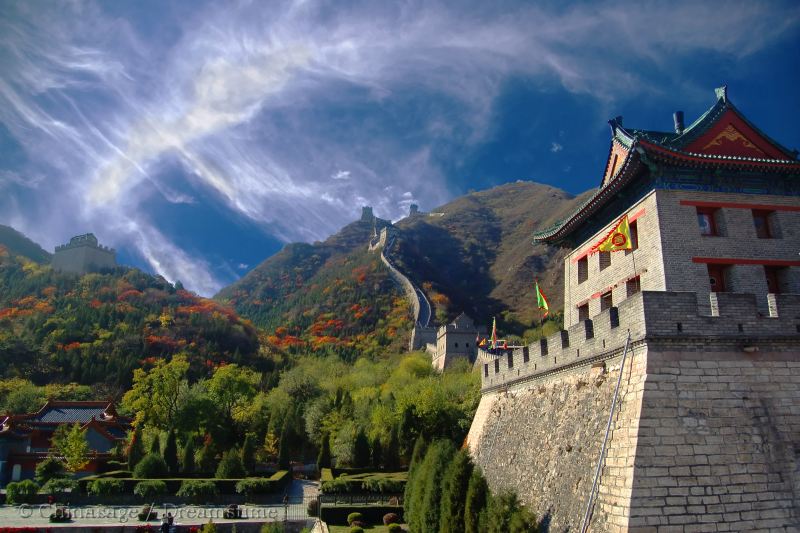
There are several places to get a good view of the Great Wall . The most famous viewing point is Badaling just north of Beijing, but these sights are so popular with tourists it is often over-crowded. However Shanhaiguan 山海关 shān hǎi guān (“The Gate between mountain and the sea”) is an equally impressive location where the Great Wall meets the sea. It was heavily fortified to prevent invasion of China along the thin coastal strip. The area was fought over during the centuries, it was one of the first actions of the Tang dynasty to build a defensive gate here. Above the main East gate are the characters proclaiming it the ‘First gate of the World’ 天下第一关 tiān xià dì yī guān. It is mostly the fortifications of Ming dynasty date that can be seen today. The town of Shanhaiguan has many historic buildings and has a Great Wall museum retelling the amazing story of the construction of the wall.
Read more…
Ming Tombs
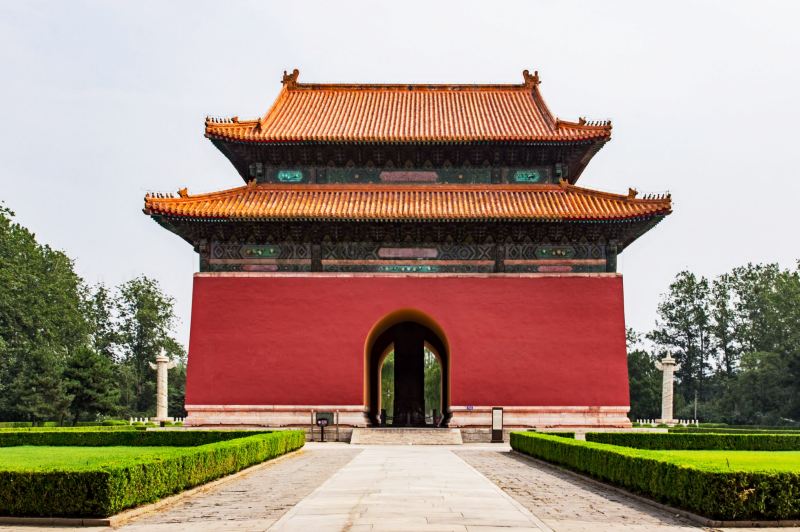
On the way from Beijing to the Great Wall at Badaling you pass the famous tombs of the Ming dynasty emperors. Buried underground are thirteen tombs only one of which has been excavated. The best way to see the Ming tombs, if you have time, is to start with the two mile Sacred Way which was the official entrance to the valley of the dead. The first tomb to see is for the founder of the whole complex: Emperor Yongle (1360-1424) where the buildings above ground were rebuilt during the Qing dynasty. Finally the tomb of Emperor Wanli is the only one to have been excavated and you can visit the burial chamber and see the archaeological finds in a nearby museum.
Read more…
Yungang Grottoes
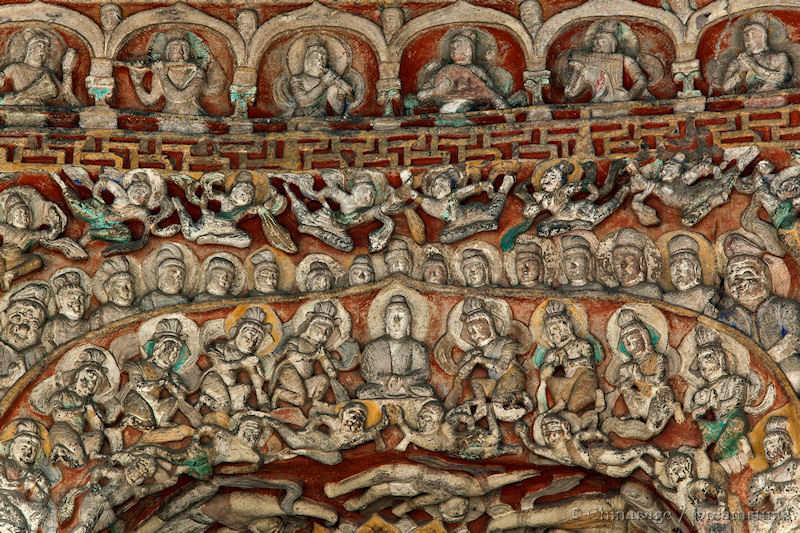
The impressive caves (云冈石窟 Yún gāng shí kū) are cut into a long sandstone cliff and contain Buddhist figures in many different shapes and sizes. The caves are not far from Datong, Shanxi close to the cradle of early Chinese civilization. The scuptures were made during the Period of Disunity (460-494CE). There are twenty or so caves lavishly decorated in different styles. Hellenistic, Persian and Indian influence can be seen in the designs and paintings.
Read more…
Mount Taishan
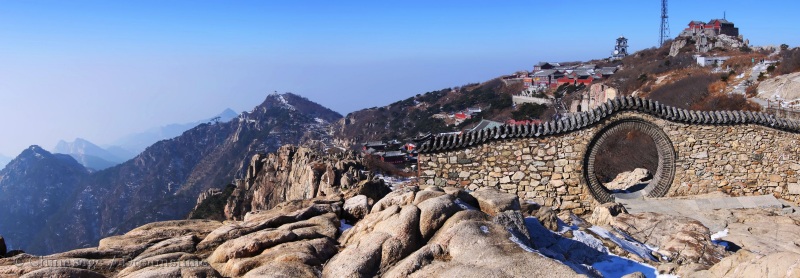
Mount Tai in Shandong province is considered the most sacred of China's many sacred mountains. It stands 5,029 feet [1,533 meters] high overlooking the North China plain criss-crossed with the wandering Yellow and Yangzi rivers. Many Chinese people climb the mountain following in th footsteps of Chinese Emperors, Confucius and even Chairman Mao Zedong. Most of the many shrines along the central path to the summit are Daoist but with some Buddhist temples too. There are cable cars to take you to the top but queues can be lengthy.
Read more…
Qufu, Shandong
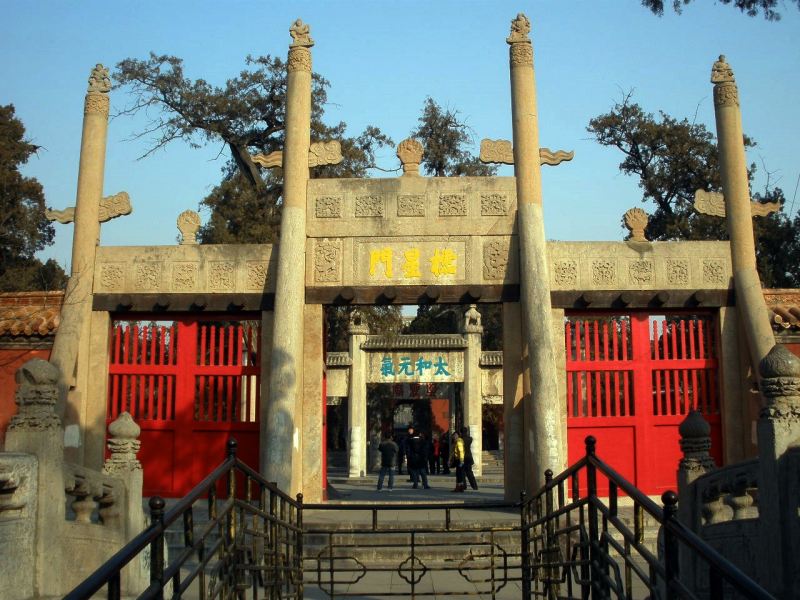
Image by Sean Shih ➚ available under a Creative Commons license ➚
The birthplace of Confucius at Qufu, China's foremost sage, remains a revered place. With a complex of temples rivaling the Forbidden City in scale and grandeur, Qufu in Shandong province is well worth a visit.
Kǒng fū zǐ 孔夫子, ‘Master Kong’, lived here 2,500 years ago, and his Kong family descendents still live here. There is a quiet and tranquil wooded area that contains Confucius’ grave and many shrines. Although greatly damaged in 1513CE, the buildings were re-created in the Ming style, there are still some historical monuments dating back to Confucius. The town attracts many pilgrims not only from China but also from Japan and Korea.
Read more…
Kaifeng
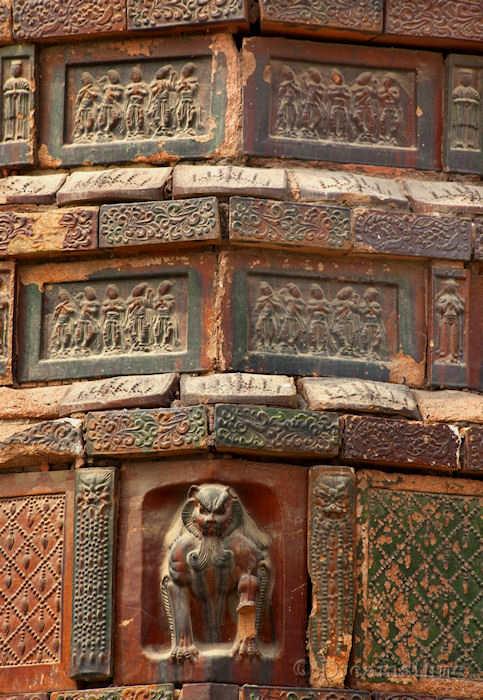
Kaifeng in Henan as one of China's ancient capitals has a great many attractions to offer the visitor. Although it was often abandoned after major flooding of the Yangzi River some historic buildings remain. The Iron pagoda (made of iron colored bricks rather than iron) is perhaps the most famous. 开封 Kāi fēng retains parts of the old city walls that enclose a number of scenic lakes. Longting Park has recreated the feel of a bustling Song dynasty city. Da Xiangguo is a celebrated Buddhist temple with a large gold statue of the Buddhist ‘goddess’ Guanyin.
Read more…
Shanghai
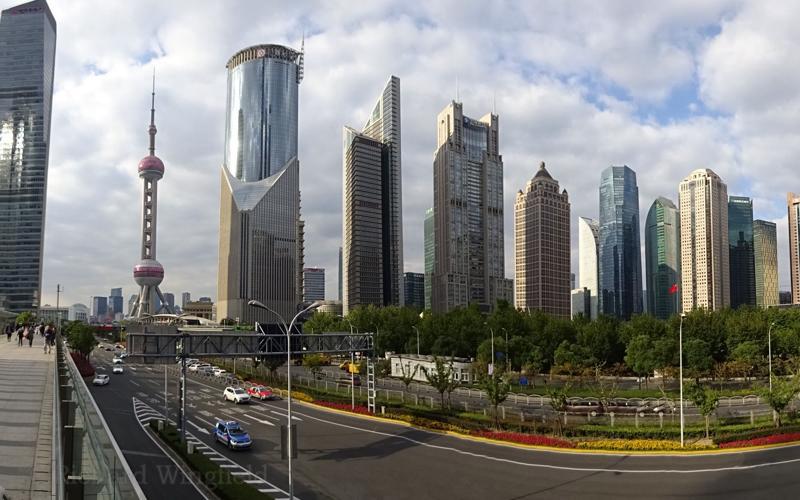
The great city of Shanghai has grown from humble origins in the mid 19th century to be China's largest and most dynamic city. What Shanghai lacks in history is made up for by modern attractions. Shanghai became a British led commercial center after the Opium Wars and grew to become the ‘Paris of the East’ up until World War 2. The mixed European architecture of the Bund gives a flavor of life at this time. In the 1990s the Pudong district was developed to provide one of the most futuristic skylines on the planet.
Read more…
Huangshan Mountains, Anhui
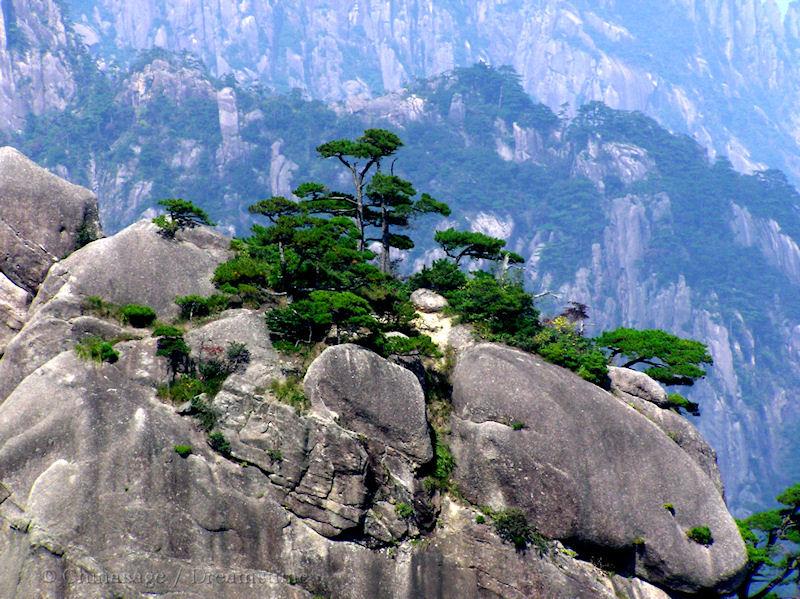
The Yellow mountain range of rugged granite is considered the finest in China and are popular with Chinese visitors. 黄山 Huáng shān or ‘Yellow mountains’ are a series of 72 peaks in southern Anhui, best reached from the town of Tunxi. The main routes are well maintained with stone steps and concrete to take the large number of people who climb the mountains at peak times. For the less athletic there are cable cars that can take you to the top.
Jingpo Lake,Heilongjiang
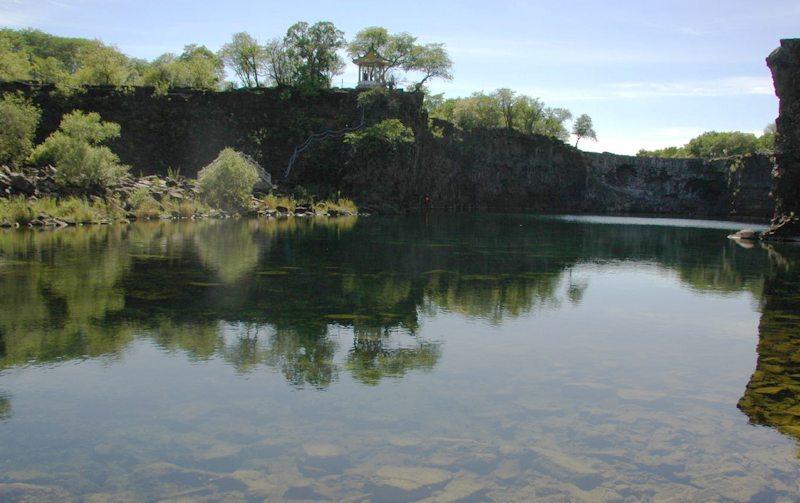
The scenic lake in the south of Heilongjiang province was formed when volcanic eruptions carved out the lake. It is surrounded with pine forests. 镜泊湖 Jìng pō hú is popular with Chinese and Russian tourists in summer with many resort facilities on the northern edge. Other parts of the reserve are tranquil and are a welcome retreat from summer heat.
Terracotta Warriors, Shaanxi
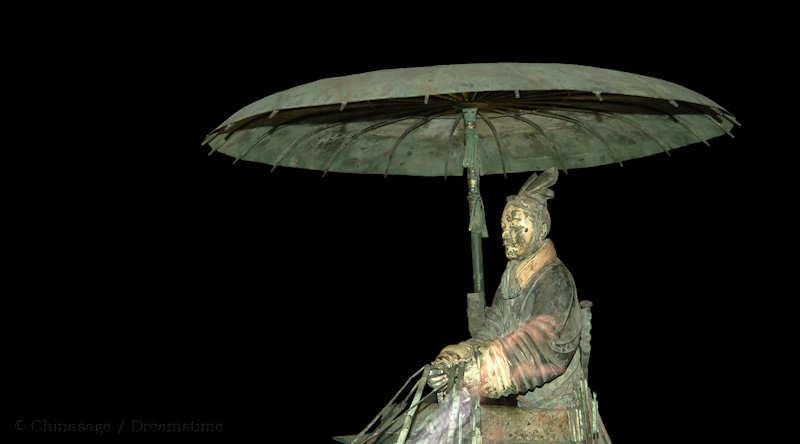
This most famous of discovery was made in 1974 just east of Xi'an in Shaanxi province. The extensive tomb complex of Emperor Qin Shihuangdi rivals all other mausoleums in the world. Only a tiny part of the tomb complex has so far been excavated. As Xi'an is built on the site of Chang'an, for a long time the capital of China and once the largest city in the world, there are many sites of immense historic interest in the immediate area.
Lushan, Jiangxi
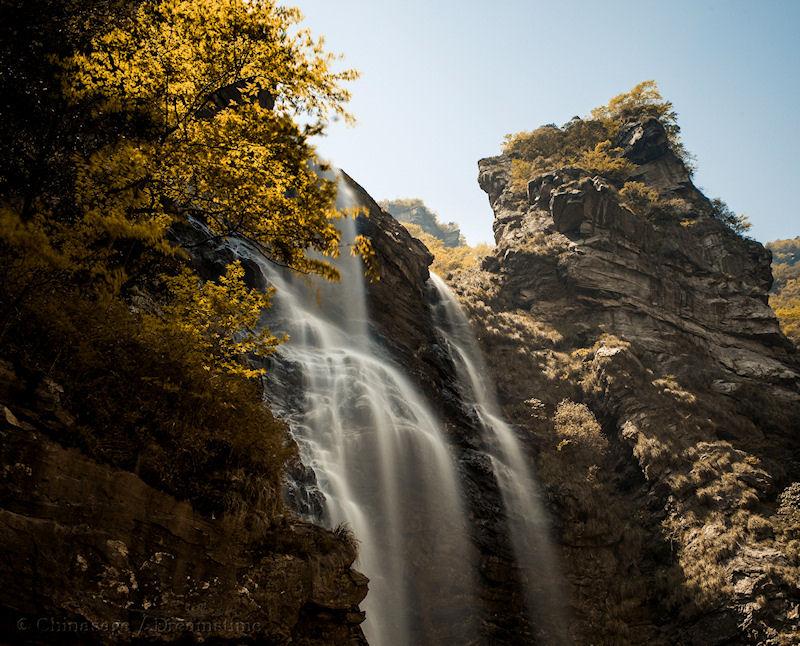
Mount Lu (庐山 Lú shān) is one of the best known mountains in China. In the 19th century Lushan was developed as a resort for europeans living in China, as the high mountains provide a welcome relief from hot summers. It was also popular with both Chiang Kaishek and Mao Zedong. It is located in the north of Jiangxi and overlooks the vast Poyang Lake. It has many paths and dramatic viewpoints including Dragon's Head Cliff.
Three Gorges Dam
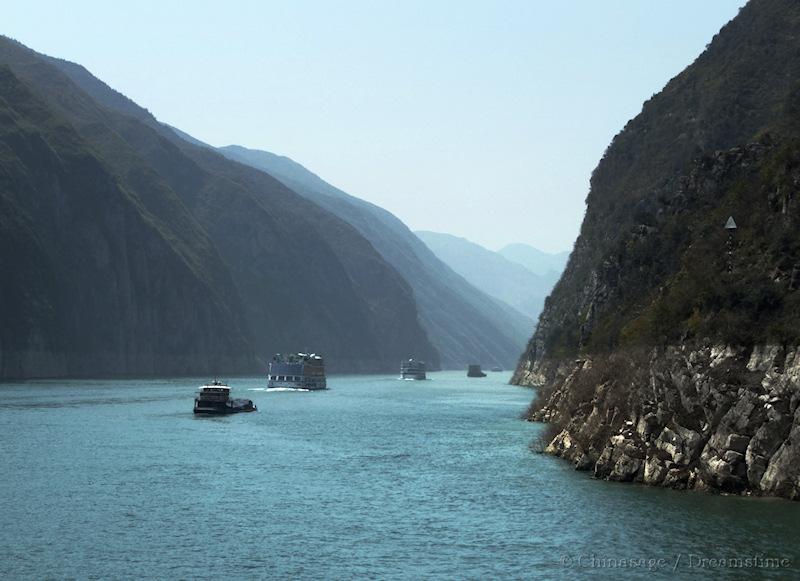
The taming of the mighty Yangzi River is a great engineering achievement which has made navigation to Chongqing safe and rapid while at the same time generating clean energy and reducing the possibility of flooding further downstream in Anhui and Jiangsu.
The Three Gorges Dam at Yichang (长江三峡水利枢纽工程 Cháng jiāng sān xiá shuǐ lì shū niǔ gōng chéng) was completed in 2008. It has the largest lock system in the world, transporting ships through three lanes of five locks to raise (or lower) them by 370 feet [113 meters]. The dam was planned as long ago as the 1930s and has displaced 1.3 million people who used to live in towns close to the river, now submerged under a 400 miles [644 kms] long lake.
Read more…
Wulingyuan mountains

Wulingyuan also known as Zhangjiajie is a mountainous, scenic area in northern Hunan. It has rocky peaks that are often shrouded in banks of mist. 张家界 Zhāng jiā jiè is the name of one of the reserves in this area. it has frequently been used in epic films when a dramatic scenic backdrop is needed such as in Avatar ➚.
Tulou houses
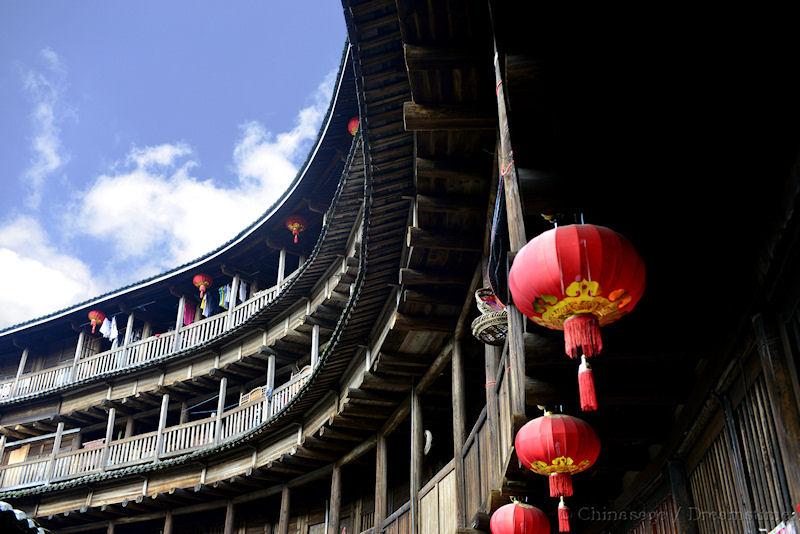
Fujian is a mountainous province facing Taiwan across the Taiwan Straits. The difficulty of transport over the mountains has led to the isolation of many communities. The Hakka people were driven out of their homelands centuries ago and some still live in traditional 土楼 Tǔ lóus (literally ‘earth buildings’). These are fortified rammed earth, round houses that house a small community or extended family. Hukeng in the Yongding area is one of the most popular places to visit. Fujian produces a great deal of tea, and there are many attractions that explain the history and production of this universal beverage.
Guilin scenery, Guangxi
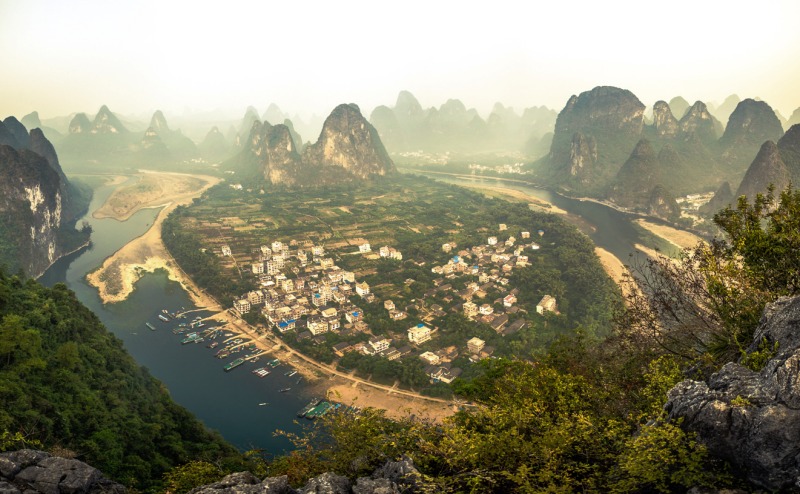
The scenic splendor of Guilin (桂林 Guì lín) and the Li River valley is famous all over China. It is the most visited example of karst scenery in China. Here the limestone has been eroded away to leave a forest of rounded peaks. Guilin in Guangxi province is surrounded by these peaks and has entranced Chinese poets for many centuries. The city is famous for its scented Osmanthus trees after which it is named. The most popular scenic trip is to take a cruise up the Li River south to Yangshuo as it meanders through the breath-taking scenery.
Pandas of Sichuan
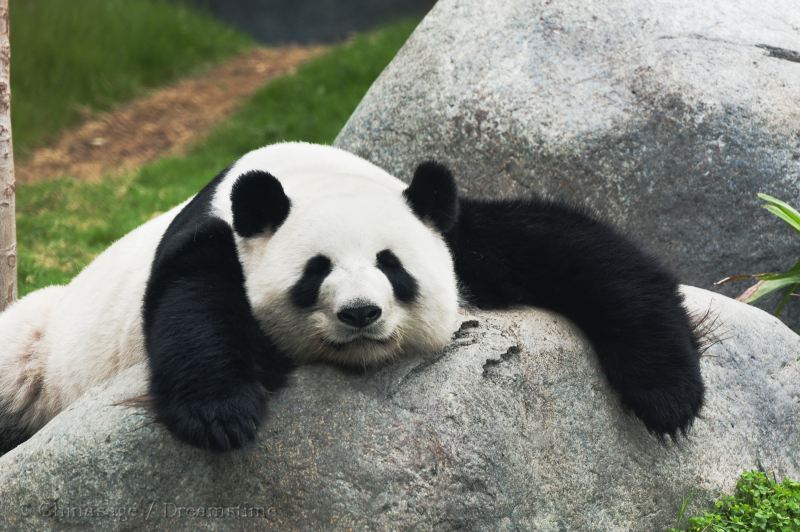
One of Sichuan's most popular attractions are the Giant Pandas at the Panda Breeding Center (成都大熊猫繁育研究基地 Chéng dū dà xióng māo fán yù yán jiū jī dì) 6 miles NE of Chengdu. The captive breeding program has helped bring back the iconic animal from the brink of extinction. The Pandas are very hard to find in the wild and the 49 reserves preserving its bamboo habitat are the best places to see them. The city of Chengdu in Sichuan is an ancient city at the heart of a hidden kingdom among the mountains. Sichuan has been the safe haven for preserving Chinese culture for many centuries. It is famed for its relaxed tea houses where you can play Chinese chess and Mahjong and sample Sichuan hot cuisine. Other visitor attractions are the hut of the poet Du Fu; Renmin Park, Qingyang Gong (Daoist temple), Yong Ling museum, Wenshu Yua and Sichuan Museum.
Read more…
Qinghai Lake
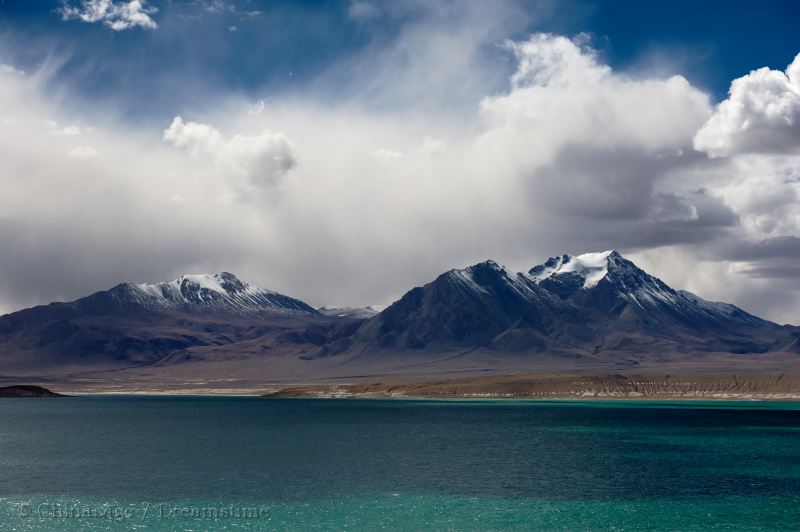
Qīng hǎi hú 青海湖 is China's largest lake 1,740 sq miles [4,507 sq kms]. Many Tibetan nomads still graze their flocks of yak and sheep on its edges. Even though it is far inland it is a salt lake as it stands in a very dry region. 鸟岛 niǎo dǎo Bird Island ➚ has a wide range of birds in the breeding season including black-necked cranes. There is a tourist center on the south side of the lake offering fishing, boating and trekking trips. The whole province of Qinghai ‘blue-green lake’ is named after the lake.
Read more…
Hong Kong
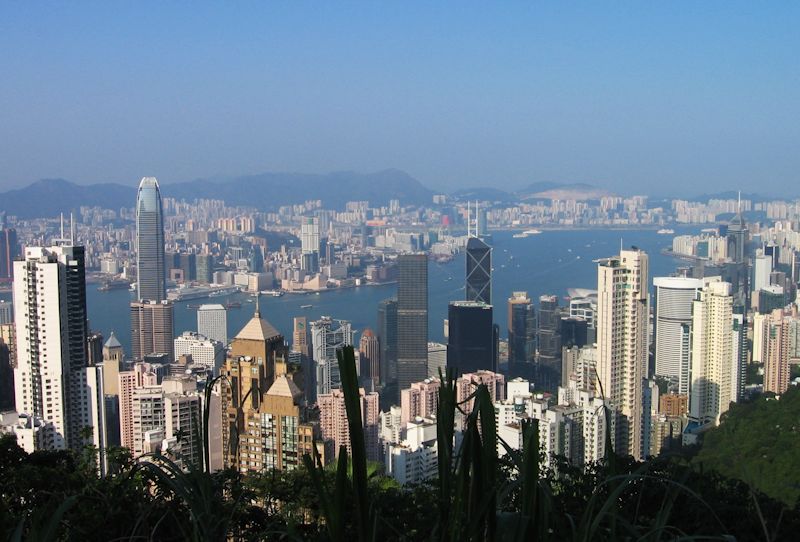
Image by Gernot Kurze ➚ available under a Creative Commons license ➚
The City of Hong Kong is a former British colony that retains some autonomy within China. Hong Kong became a very affluent city during the early years of the People's Republic. It acted as a gateway for finance and goods entering China. Finance remains a key activity. Despite the dense and busy city areas, Hong Kong has unspoilt rural retreats among the mountains and islands that offer a welcome change including botanic gardens and nature reserves. Its southern position on the South China Sea brings in a lot of warm, moist air for most of the year.
Read more…
Mount Emei, Sichuan
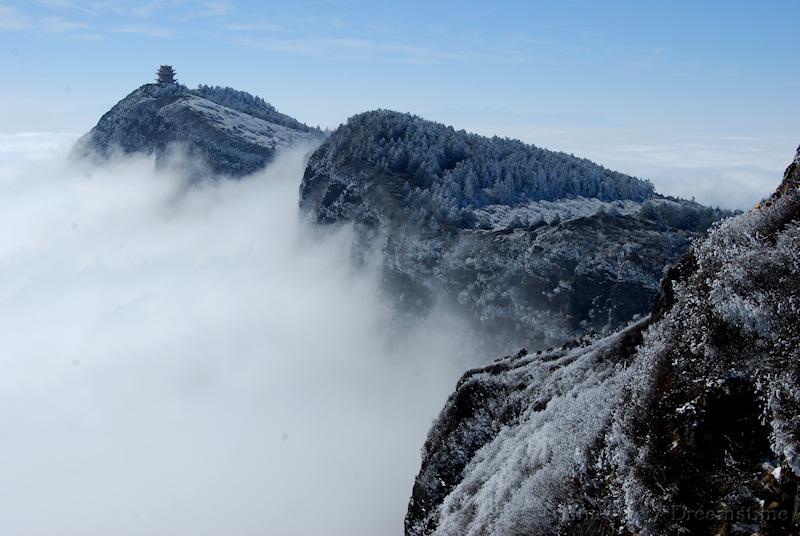
Éméi shān 峨嵋山 is one of China's most sacred mountains. At 10,167 feet [3,099 meters] it is a grueling climb to the top. The path meanders through Buddhist and Daoist temples that act as convenient staging posts. The modern traveler can reach the summit more conveniently by cable car. The mountain slopes are covered in interesting plants and there are troupes of monkeys that beg for food from the many visitors.
Waterfalls, Guizhou
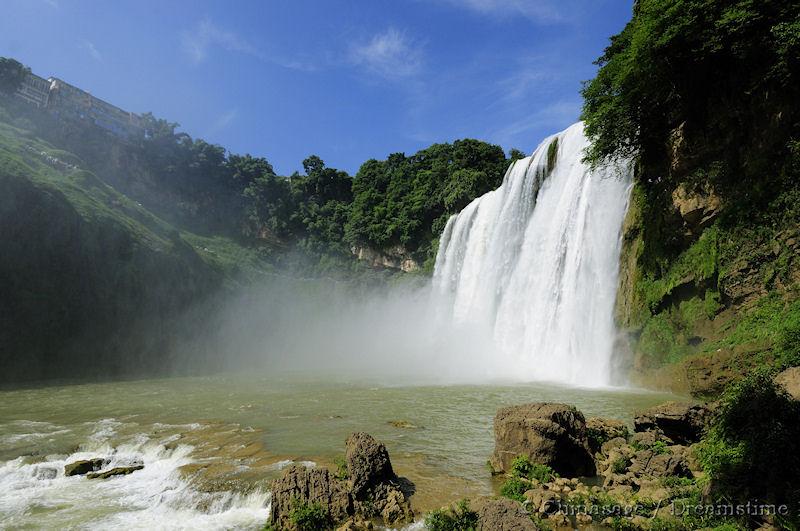
Huangguoshu (黄果树瀑布 Huáng guǒ shù pù bù) are impressive waterfalls on the Sanche River, the most famous in China. They fall a dramatic 223 feet [68 meters]. It is the main scenic attraction of Guizhou province. They are best seen when the river is at a high level in summer.
Dunhuang Caves, Gansu
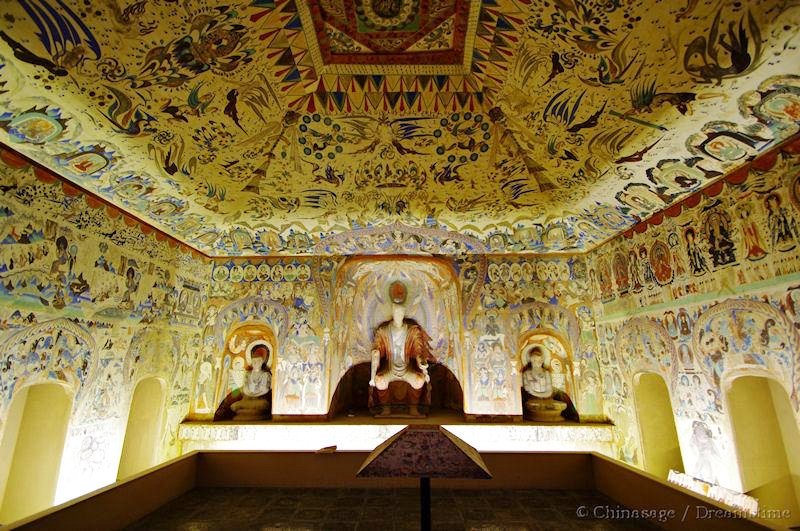
The Mogao Caves near Dunhuang, Gansu holds some of the most beautiful early Buddhist sculptures and paintings. Dunhuang was on the Silk Road and Buddhists would use this route to travel to and from India. Over a thousand years of changing artistic styles is documented by the colorful frescoes of the caves (莫高窟 Mò gāo kū). When the desert road was abandoned the impressive relics, including the earliest printed book, were forgotten and buried in sand before their re-discovery the late 19th century.
Stone Forest, Yunnan
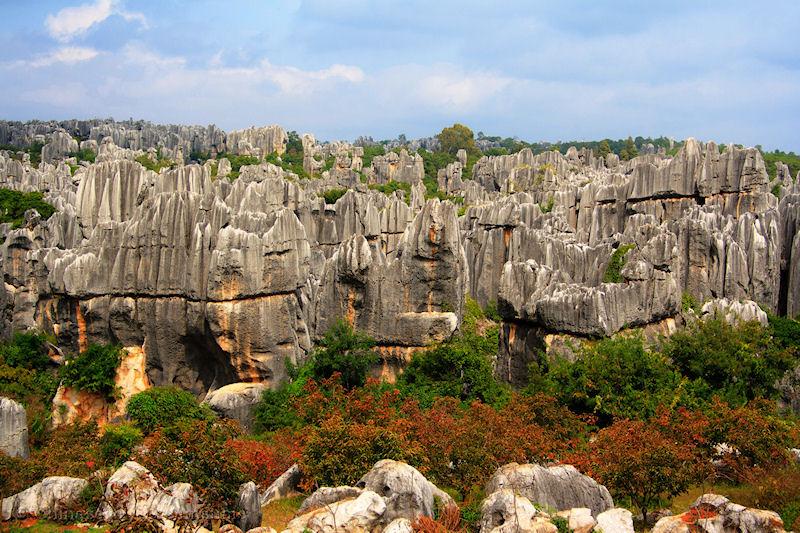
Shilin 石林 is an area of dramatic limestone pillars that look like a forest made of stone. Some 'trees' rise to 100 feet [30 meters] and many have been given imaginative names. Some of the columns are inscribed with poems and there are six pools that add to the beauty of the scene. This area of Yunnan province is home to the Sani minority people who often act as tour guides and take part in demonstration dances to the delight of visitors.
Dali Lake, Yunnan
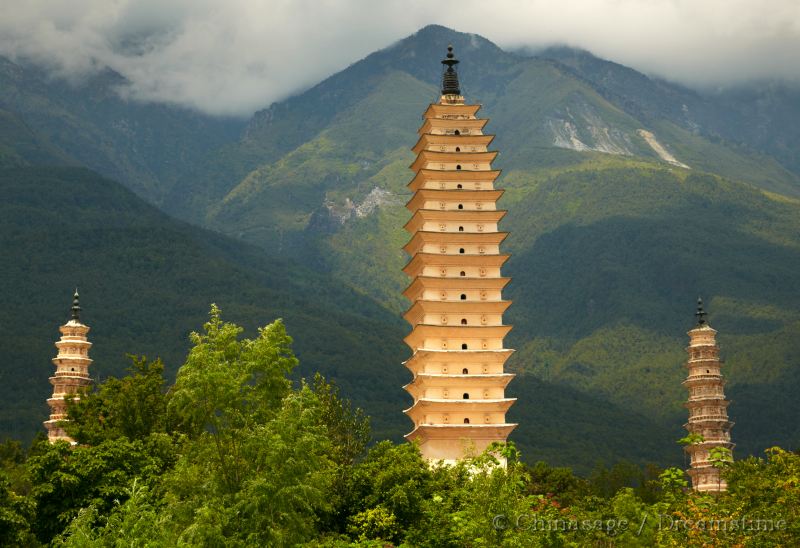
The province of Yunnan borders Laos, Myanmar and Vietnam and cultural influences of these countries is strong here. Many different minority people populate the mountainous terrain of Yunnan. (洱海 Ěr hǎi) or Dali Lake is home to the Bai people. Boat trips can be taken on the scenic waters. The ancient town of Dali draws many visitors and picturesque San Ta (Three Pagodas) is located just a mile north west of Dali.
Turpan, Xinjiang
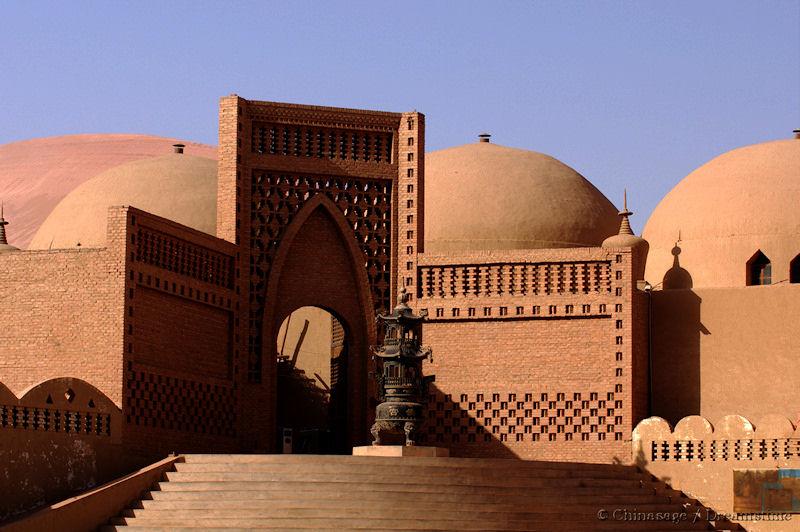
The deserts around Turpan, Xinjiang are the hottest in China (121 ° F [49 ° C]) , and because Turpan lies in a depression (505 feet [154 meters] below sea level) the heat is trapped. Grapes are the most famous produce from Turpan. The town is irrigated by a system of covered water channels bringing precious water from far away hills. The area was settled by Uighur people in the 7th century who converted to Islam and mosques such as the ‘Imin Ta’ were built in the Persian style.
Lhasa, Tibet
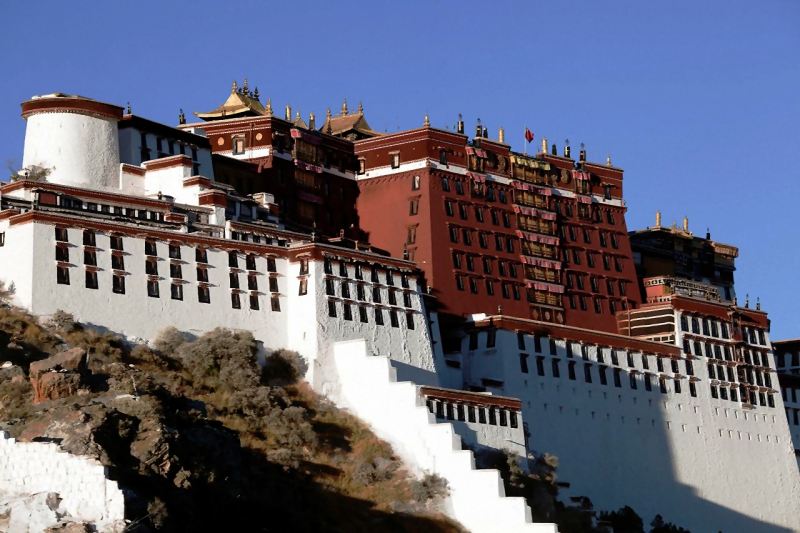
Image by *Christopher*’s ➚ available under a Creative Commons license ➚
Tibet holds many attractions of interest to visitors. The high places are a world apart from the hot bustling cities of eastern China. Lhasa is the cultural and provincial capital of the province of Tibet and is situated in the dramatic Zhangpo valley, one of the few fertile areas within the province. The Potala Palace and some parts of the city of Lhasa date to the 7th century. It was the palace of the Dalai Lama before his flight to northern India in 1958. The Palace is built on an isolated small mountain in the middle of the town of Lhasa.
Kashgar, Xinjiang
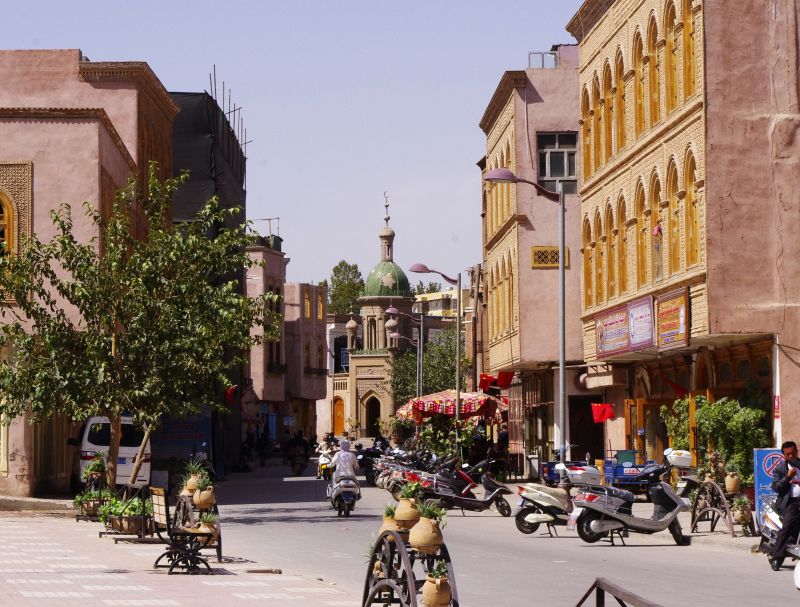
The ancient city is near the border with Pakistan, Kyrgyzstan, Tajikistan and Afghanistan on the Karakorum Highway to the Hunza Valley and Khunjerab Pass. Kashgar, Xinjiang province, known in China as 喀什 Kā shí, has remained a stronghold of Islam since the 9th century and was not annexed by China until the Qing dynasty. It is famous for many ancient sights including the Caves of the Three Immortals, the Tomb of Yusup Hazi Hajup and the Aba Khoja Mausoleum. It has a shared culture with its Muslim neighbor states.
Map showing the location of all these visitor attractions in China.
